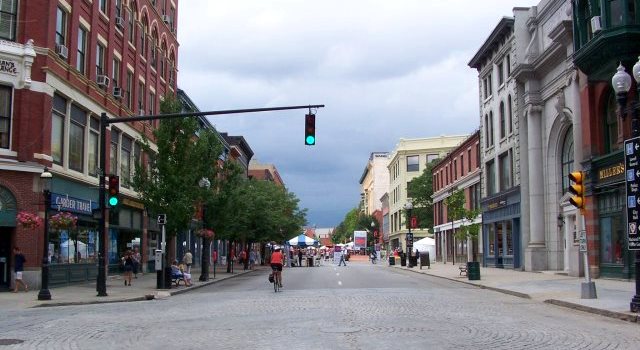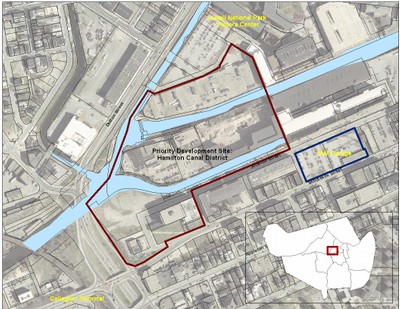Connecticut has seen a lot of interest and activity in transit-oriented development (TOD) lately!
The Partnership for Strong Communities’ workshop “How the Knowledge Corridor’s Towns Can Make TOD Work for Them” drew almost 100 attendees. New Haven residents heard about the mixed-use redevelopment plans for the former Coliseum site, located within walking distance of Union Station. In Meriden, the state Department of Transportation met with the public to share a proposed design for the new train station, which includes enhancements to attract private development around the station.
And on June 4, a group of twenty TOD advocates and Connecticut officials travelled to Massachusetts to see TOD projects in Lowell and Melrose, followed by a visit to the Metropolitan Area Planning Council in Boston. The bus trip was organized by Tri-State Transportation Campaign, and was co-sponsored by Connecticut Fund for the Environment, Partnership for Strong Communities and Regional Plan Association.

The City of Lowell Surges Forward
Adam Baacke, assistant city manager for Lowell, credited the city’s resurgence to a number of strategies. “Historic preservation has been our core driver of economic growth,” remarked Baacke, noting how the creation of the Lowell National Historical Park sparked surrounding downtown development. “We drew upon our industrial past and turned it into an asset.” The park and the city have worked together to assist in the rehabilitation of over 250 historical downtown structures during the last quarter century.
“City-wide partnerships have been crucial,” said Baacke. He explained how CEOs in the Lowell area came together to form The Lowell Plan, Inc., a private non-profit economic development organization which crafted a vision and plan for Lowell’s comeback. The Lowell Development & Financial Corporation, a partnership of banks, has provided much-needed, low-cost start-up loans to 36 businesses.
“The city provides parking too,” Baacke reported, “and we remove this expense from the developer’s cost equation, creating an incentive for development.” The Connecticut tour group was able to see firsthand Lowell’s vibrant and walkable downtown retail district.
The Hamilton Canal District: TOD around the Gallagher Terminal
The final stop in the Lowell tour was the Hamilton Canal District, an upcoming 15-acre, mixed-use redevelopment project that is expected to transform the gateway into the city by connecting the Gallagher Terminal transportation hub and Lowell Connector with the downtown core. The developer envisions up to 750 residential units along with commercial and retail space.

The city did the land assembly for the project and secured the master developer, Trinity Financial of Boston, which led the community engagement process. The city also reduced the developer’s site clean-up risk by reducing the land price to make up for the cost of contamination removal.
“We found that the developer driven community process worked very well for us and that we had buy-in from all parties,” said Baacke.
The State of Massachusetts’s Role in Reviving Lowell
The state has been an invaluable partner in Lowell’s revival, said Baacke. Massachusetts has recognized a state interest in places like Lowell for two key reasons. First, attracting and retaining millennial-generation talent requires compelling, authentic urban environments that they find attractive to live and work in. In this regard, gateway cities like Lowell are less expensive alternatives to Boston/Cambridge. Second, the state feels strongly that housing production, especially multi-family housing production, is essential to the state economy. Unfortunately, it’s very difficult to develop housing in much of Massachusetts due to local control and tight land use regulation. As a result, the state is eager to support places where the municipality welcomes housing development.
For these reasons, the state has provided grant funding for infrastructure design and construction, housing assistance to mill redevelopment projects, state historic rehab tax credits for various projects, and funding under their Growth District program to support the Appleton Mill redevelopment in the Hamilton Canal District.
Connecticut: A Special Moment in Time
Connecticut has a huge opportunity to leverage transit investments like CTfastrak and the upcoming improvements to the New Haven – Hartford – Springfield Rail project to boost the economy and wisely develop our communities for the 21st century.
Last December, Governor Malloy announced the creation of an interagency workgroup to address the transit-oriented development needs of the state. We look forward to the workgroup partnering with housing and environmental advocates, businesses, developers and the legislature in developing policies to systematically and successfully promote TOD. Most of all, we look forward to the day when we can look at our TOD locales with pride and when other states will be looking to emulate Connecticut’s success.
You can learn more about CFE’s work on transit and transit-oriented development on our website.
Posted by Chris Cryder, Special Projects Coordinator for CFE/Save the Sound and coordinator of Growing CT Around Transit, CFE’s TOD workgroup
